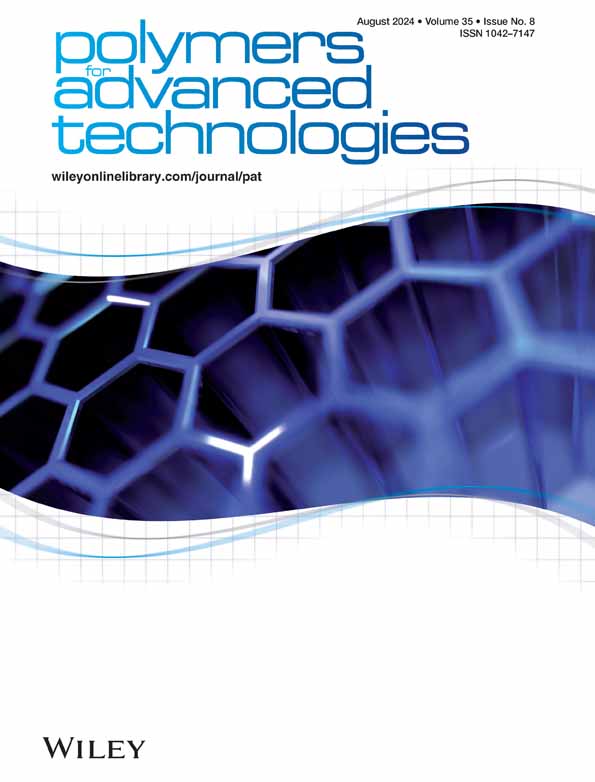弹性体增韧剂和成核剂对聚丙烯机械性能和结晶行为的协同增韧效应
IF 3.4
4区 工程技术
Q2 POLYMER SCIENCE
引用次数: 0
摘要
一种新型热塑性弹性体、核仁树脂(KN)、α-成核剂(HPN)和β-成核剂(DCHT)作为增韧剂和成核剂(NAs),被用于改善同向聚丙烯(PP)的机械性能和结晶行为。PP/KN 共混物的冲击强度随着 KN 浓度的增加而显著提高。令人惊讶的是,加入 NA 后,PP/KN/NA 共混物的冲击强度进一步提高。DCHT 的增韧效果强于 HPN。当 DCHT 含量为 0.05% 时,PP/KN/DCHT 共混物的最大冲击强度达到 69.2 kJ/m2,是纯 PP 的六倍。共混物断裂表面的扫描电镜图像显示出从脆性断裂到韧性断裂的转变。此外,WAXD 结果表明,HPN 的加入促进了 PP α 结晶形式的形成。添加 DCHT 则会诱导 PP 产生 α-β 晶体转变。此外,差示扫描量热法显示,加入 KN 和 NA 可提高 PP 的结晶性和整体结晶速率。PP 在 128°C 的半结晶时间从 5.52 分钟(纯 PP)缩短到 0.34 分钟(PP/KN/DCHT-0.3)。本文章由计算机程序翻译,如有差异,请以英文原文为准。
Synergistic toughening effects of elastomer toughener and nucleating agent on mechanical properties and crystallization behaviors of polypropylene
A novel thermoplastic elastomer, kernel resin (KN), α‐nucleating agent (HPN), and β‐nucleating agent (DCHT), which acted as toughener and nucleating agents (NAs), were used to improve the mechanical properties and crystallization behaviors of isotactic polypropylene (PP). The impact strength of the PP/KN blends increased significantly with increase in KN concentration. Surprisingly, the impact strength of PP/KN/NA blends improved further upon addition of NA. The toughening effect of DCHT was stronger than that of HPN. The maximum impact strength of PP/KN/DCHT blend reached 69.2 kJ/m2 when the DCHT content was 0.05%, which was six times higher than that of neat PP. The SEM images of fractured surfaces of the blends showed a change from brittle fracture to ductile fracture. Moreover, the WAXD results showed that the incorporation of HPN promoted the formation of the α form of crystalline PP. Addition of DCHT induced the generation of α‐β crystal transition of PP. Furthermore, differential scanning calorimetry showed that the crystallizability and the overall crystallization rate of PP were enhanced by the addition of KN and NA. The half‐crystallization time of PP at 128°C decreased from 5.52 (neat PP) to 0.34 min (PP/KN/DCHT‐0.3).
求助全文
通过发布文献求助,成功后即可免费获取论文全文。
去求助
来源期刊

Polymers for Advanced Technologies
工程技术-高分子科学
CiteScore
6.20
自引率
5.90%
发文量
337
审稿时长
2.1 months
期刊介绍:
Polymers for Advanced Technologies is published in response to recent significant changes in the patterns of materials research and development. Worldwide attention has been focused on the critical importance of materials in the creation of new devices and systems. It is now recognized that materials are often the limiting factor in bringing a new technical concept to fruition and that polymers are often the materials of choice in these demanding applications. A significant portion of the polymer research ongoing in the world is directly or indirectly related to the solution of complex, interdisciplinary problems whose successful resolution is necessary for achievement of broad system objectives.
Polymers for Advanced Technologies is focused to the interest of scientists and engineers from academia and industry who are participating in these new areas of polymer research and development. It is the intent of this journal to impact the polymer related advanced technologies to meet the challenge of the twenty-first century.
Polymers for Advanced Technologies aims at encouraging innovation, invention, imagination and creativity by providing a broad interdisciplinary platform for the presentation of new research and development concepts, theories and results which reflect the changing image and pace of modern polymer science and technology.
Polymers for Advanced Technologies aims at becoming the central organ of the new multi-disciplinary polymer oriented materials science of the highest scientific standards. It will publish original research papers on finished studies; communications limited to five typewritten pages plus three illustrations, containing experimental details; review articles of up to 40 pages; letters to the editor and book reviews. Review articles will normally be published by invitation. The Editor-in-Chief welcomes suggestions for reviews.
 求助内容:
求助内容: 应助结果提醒方式:
应助结果提醒方式:


